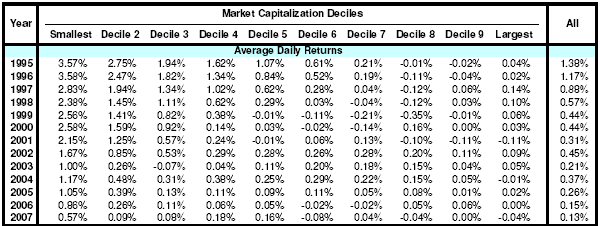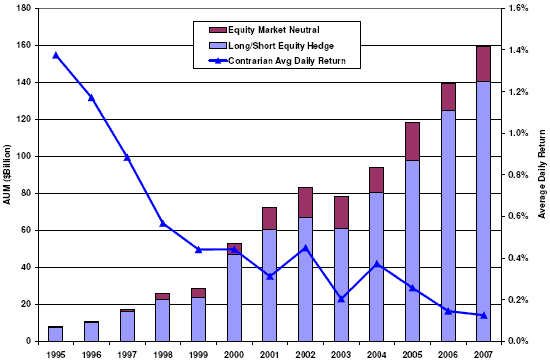Have hedge funds proliferated, grown and leveraged to the point that groups of them with similar quantitative strategies can crash as they try to exit common positions in response to some external trigger? In their September 2007 paper entitled “What Happened To The Quants In August 2007?”, Amir Khandaniy and Andrew Lo investigate the hypothesis that similar market-neutral and long/short equity hedge funds suffered a cascading fire sale liquidation (one-month losses of 5%-30%) during early August 2007. Using daily return data for a broad set of stocks to model hedge fund performance over the period 1/95-8/07, they tentatively conclude that:
- The profitability of simple contrarian long/short equity strategies has declined steadily since 1995 (see the first table below for a simple example), arguably because the number and size of market-neutral and long/short equity hedge funds has grown dramatically (see the chart below).
- In the face of eroding returns, hedge funds typically increase leverage. The leverage factor required to maintain the same average daily return from simple contrarian long/short equity strategies increased by 4.5 times from 1998 to 2007.
- Extreme deviations from the normal return pattern for simple contrarian long/short equity strategies during 8/7/07-8/10/07 (see the second table below) may have caused a large fund to liquidate, thereby triggering a stampede for the exit by funds with similar strategies. A highly leveraged fund using such a strategy would have lost over 25% of its value during 8/7-8/9, and capitulation (de-leveraging) by 8/9 would have precluded recovery on 8/10. In general, hedge funds competing with similar strategies also compete for the same assets and the same liquidity. If they seek liquidity at the same time, there is not enough to go around.
- Correlations of returns among different types of hedge funds have grown over the past decade, indicating increased financial markets integration and risk of cross-market contagion (for example, from mortgage debt instruments to equities).
- Hedge fund cascades pose a risk to the financial system. “If we were to develop a Doomsday Clock for the hedge-fund industry’s impact on the global financial system, calibrated to 5 minutes to midnight in August 1998, and 15 minutes to midnight in January 1999, then our current outlook for the state of systemic risk in the hedge fund industry is about 11:51pm. For the moment, markets seem to have stabilized, but the clock is ticking…”
The following table, extracted from the paper, shows the steady decline in average daily returns of a simple contrarian hedge strategy that is short (long) yesterday’s winners (losers). It also shows that small capitalization stocks have offered the greatest returns for this strategy, neglecting transaction costs and other trading frictions. Due to lack of liquidity in small-capitalization stocks, hedge funds probably concentrate efforts on mid-range capitalizations.

The following chart, taken from the paper, compares 1995-2007 beginning-of-year Assets Under Management (AUM) from a large database of Long/Short Equity Hedge and Equity Market Neutral funds to the average daily returns of the above simple contrarian hedge strategy. As hedge funds assets grow, returns fall. To maintain the returns to fund holders, fund managers have had to increase leverage.

The next table, also extracted from the paper, shows the very unusual behavior of the above simple hedging strategy for four days during early August 2007. Across all capitalizations, the loss during 8-7-8/9 and the gain on 8/10 represent 11-12 standard deviation events. Leveraged funds following such a quantitative strategy could have seen their assets first fall and then rise by more than 20% during these four days. Funds that capitulated by 8/9 would not have rebounded.

The authors note that evidence with regard to their 8/7/07-8/10/07 scenario is largely circumstantial.
In summary, hedge funds may be more risky than their quantitative strategies indicate because the strategies do not account for the effects of fund growth, proliferation of similar funds and increased leverage. The hedge fund party may have become so crowded that, when someone yells “Fire!”, the exit door cannot handle the computer-driven panic.